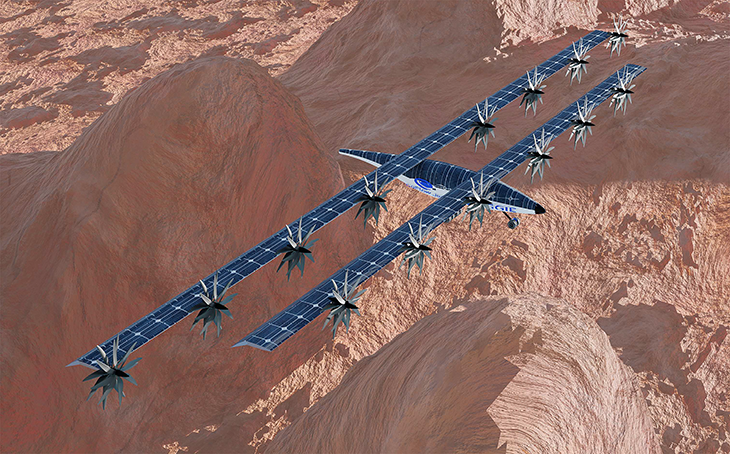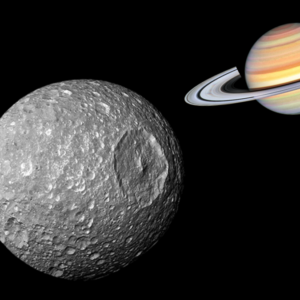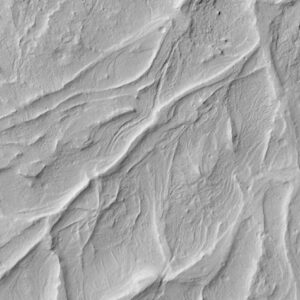
NASA has greenlit an ambitious project aimed at revolutionizing aerial exploration on Mars: a groundbreaking vertical take-off aircraft design. This innovative endeavor, aptly named MAGGIE (Mars Aerial and Ground Global Intelligent Explorer), has secured advanced grant funding and aims to take flight on the Red Planet within the next six years.
At its core, MAGGIE represents a fusion of cutting-edge technology and bold imagination. It is envisioned as a compact fixed-wing electric aircraft, drawing its power from solar energy to navigate the Martian atmosphere. To conceptualize its form, envision the iconic silhouette of the Wright Flyer, but with its wings replaced by solar panels, harnessing the distant Martian sunlight to propel itself through the skies.
The versatility of MAGGIE is one of its defining features. Designed for vertical take-off and landing, it promises to navigate the Martian terrain with agility and precision. With a projected top speed exceeding 100 miles per hour and an operational altitude of 3,300 feet, it will provide a swift and efficient means of exploration across the Martian landscape.
What sets MAGGIE apart is not only its ambitious design but also its reliance on invaluable insights gleaned from previous Martian missions. The flight data collected by the diminutive yet pioneering Ingenuity Mars Helicopter, which embarked on over 30 successful flights, serves as a cornerstone for MAGGIE’s development. From wind resistance to airspeed, these metrics have provided crucial guidance for engineering an aircraft capable of navigating the unique challenges posed by the Martian atmosphere.
Indeed, the Martian environment presents a host of obstacles to overcome. With an atmosphere 160 times thinner than Earth’s, MAGGIE faces a formidable task in achieving sustained flight. To address this challenge, the aircraft’s design incorporates a cruise lift coefficient nearly an order of magnitude higher than conventional subsonic aircraft. This innovative approach underscores the ingenuity required to conquer the inhospitable skies of Mars.
As MAGGIE moves forward into the realm of reality, it embodies humanity’s relentless spirit of exploration and discovery. With each milestone achieved, it brings us one step closer to unlocking the mysteries of the Martian landscape and expanding the frontiers of human knowledge.
“The representative mission for MAGGIE presented would… include a study of the origin and timing of the Martian core dynamo from the weak magnetic fields found in the large impact basins, a regional investigation of the source of methane signals detected by the Tunable Laser Spectrometer on the Mars Science Laboratory in Gale crater, and mapping of subsurface water ice at high resolution in the mid-latitudes where it has been observed from orbit,” Ge-Cheng Zha of the Florida-based developers Coflow Jet, LLC, explained.
Supported by a NASA grant initiative known as NIAC (NASA Innovative Advanced Concepts), MAGGIE is currently in its nascent stages of development, yet it holds the potential to transform the exploration of nearly all corners of the Martian terrain.
NIAC has provided backing to a diverse array of ambitious ventures, ranging from asteroid mining technologies to fungal housing kits for potential habitation on Mars.
“The daring missions NASA undertakes for the benefit of humanity all begin as just an idea, and NIAC is responsible for inspiring many of those ideas,” NASA Associate Administrator, Jim Free, also said.
“The Ingenuity helicopter flying on Mars and instruments on the MarCO deep space CubeSats can trace their lineage back to NIAC, proving there is a path from creative idea to mission success. And, while not all these concepts will fly, NASA and our partners worldwide can learn from fresh approaches and may eventually use technologies advanced by NIAC.”
What are your thoughts? Please comment below and share this news!
True Activist / Report a typo



